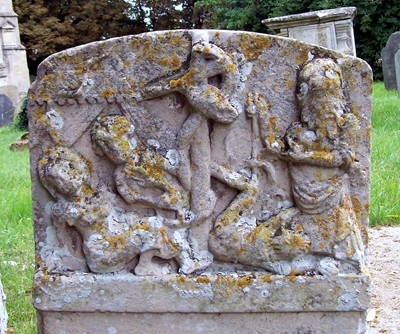|
The brass serpent tombstone
One of the more interesting
tombstones in the churchyard dates from the 17th century and is
elaborately carved with a biblical scene from the Old Testament which has
been described as the plague of snakes, no doubt a reference to Exodus
which recounts the events resulting in Moses leading the Israelites out of
slavery through the Red Sea which parted to allow them cross and so on to
Palestine and freedom. Pask Matthews was a worshipper at the Abbey
Church where he took a particular interest in the building and this short
history which appeared in 1951, became so popular that it ran to five
editions and remains the starting point today for historians researching
the 12th century church.
It included several pen sketches by Mrs A E Macleod, among them one of
this carved tombstone which he quite clearly identifies as “representing
The Plague of Snakes” although this is not exactly correct. The bible
describes ten plagues which came in two waves, the first five being the
Nile turning to blood, frogs, lice, flies and the death of all livestock,
but when Pharaoh refused to budge, there followed five more, boils, hail,
locusts, darkness and the death of the first born and when this came to
pass, as the bible reports, “the Pharaoh finally sent the Israelites
away”. 6. And the Lord sent fiery serpents among the people, and they bit the people; and much people of Israel died. 7. Therefore the people came to Moses, and said, We have sinned, for we have spoken against the Lord, and against thee; pray unto the Lord, that he take away the serpents from us. And Moses prayed for the people. 8. And the Lord said unto Moses, Make thee a fiery serpent, and set it upon a pole: and it shall come to pass, that every one that is bitten, when he looketh upon it, shall live. 9. And Moses made a serpent of brass, and put it upon a pole, and it came to pass, that if a serpent had bitten any man, when he beheld the serpent of brass, he lived. This narrative is the subject of many illustrations, particularly engravings, oil paintings and stained glass windows which compare favourably with the carving on the tombstone and depicting the brass serpent on the pole with Moses looking on and several people who had come to be saved recovering from their snake bites. Unfortunately, wind and weather have taken their toll on the stonework over the centuries and so we are unable to find out who is buried below or the exact date of death which would provide a clue to further research and perhaps establish why a picture from this particular story was used as a memorial. There must have been a very good reason to do so, perhaps because the person who occupies the grave was bitten by an adder and died as a result. Who knows? WRITTEN JULY 2010 See also An architectural history of the church The churchyard Epitaphs
Go to: Main Index Villages Index |
